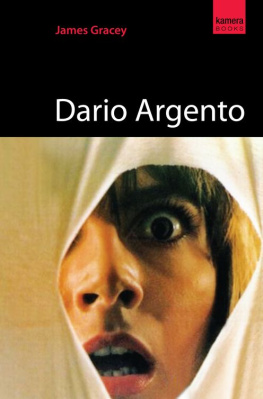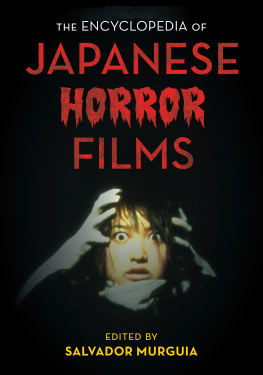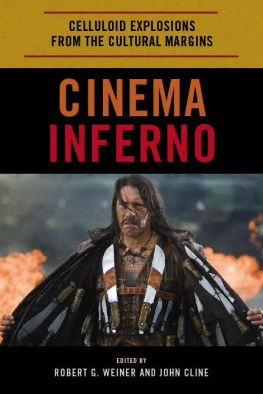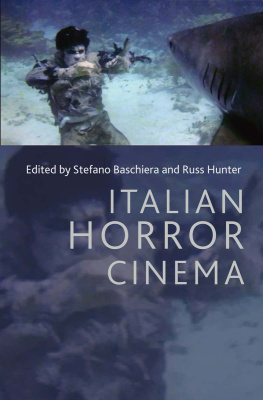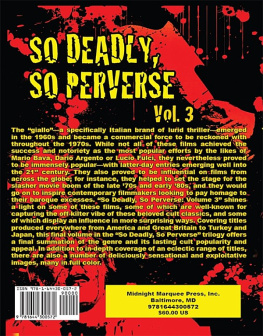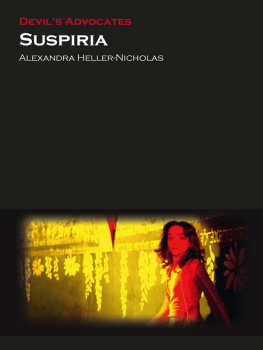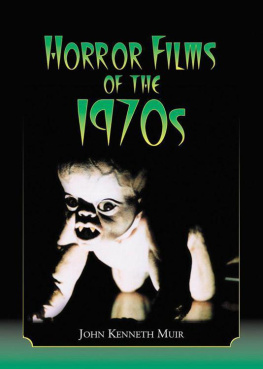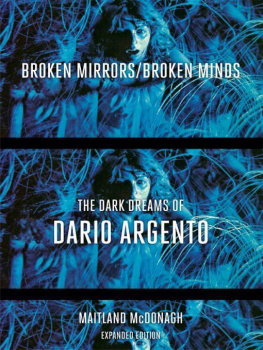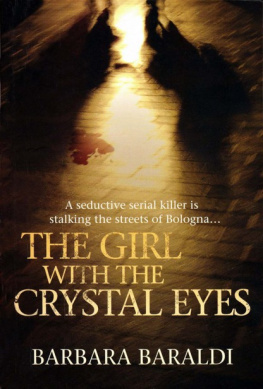Thanks to Mum, Dad, Scott and Chloe for all the smiling and nodding as I endlessly enthused about all things Argento.
From the bottom of my ventricles I would also like to thank the following people for endless encouragement, eye rolling and proof-reading abilities of the highest order: Emma Kelly, John McAliskey, Caroline Ryder, Alastair Crawford, Lucy Wood, John Kerr Mitchell, Craig Smith, Terri McManus and Shauneen Magorrian, all of whom also successfully managed to avoid watching anything that even remotely resembled an Italian horror film throughout the course of this project which was no mean feat! Thank you so much guys.
Thank you to the following for all their support: Christine Make-peace and Dylan Santurri at Paracinema magazine, Amber Wilkinson at Eye for Film and Francis Jones, Jonny Tiernan and all at AU.
Diolch yn fawr Ernest Mathijs and Mikel Koven, for sharing an inclination towards the darker side of cinema and corrupting the mind of a simple slasher-movie fan. Thanks also to Vikkie Taggart, for introducing me to ALL the Dario Argento fans and to Michael Bugajer for his helpful suggestions.
Id also like to express my sincere gratitude to Sean Keller, Coralina Cataldi-Tassoni and Marco Werba for their valuable time, insight and generosity.
Last, but certainly not least, many thanks to Anne Hudson for all her guidance and advice, and to Ion Mills and Hannah Patterson for providing me with the opportunity to write about one of my favourite filmmakers.
For over 40 years now the breathtakingly violent and stylish films of Dario Argento have been shocking and terrifying audiences around the world. To watch an Argento film is to indulge in a totally visceral experience. Elaborate set pieces and dazzling cinematic artistry collide in a cacophony of blood and sinew. The camera is used like a weapon, ceaselessly prowling for its prey. Strange point-of-view shots align the viewer with both pursued and pursuer, implicating the audience in each ostentatious depiction of murder and mayhem. Attractive female victims glance back longingly as they flee in abstract terror, all too aware of their own vulnerability. At times almost sensual, each murder is filmed as though it were something more closely aligned with a sex scene; a frenzy of flesh and blood, culminating in a disturbing orgasm of bloody chaos. Lashings of bizarre and fetishistic images abound in Argentos work. One such recurring image is that of the killers hands, clad in black leather gloves, fondling various sharp implements of death. The fact that Argentos own hands usually stand in for the killers in these shots adds an additional dimension of perversity. Argento utilises images and sound, the very language of cinema, to further his twisted narratives in which logic is all but lost in a constant bombardment of nightmarish and extravagant style.
Argento is often referred to as the Italian Hitchcock as he has made a name for himself creating scenes of terror and tension. Though Hitchcocks work is marked by its staunch linearity, focused plotting, narrative and logic, in Dario Argentos films these are often usurped in favour of atmosphere, technical prowess and provocative imagery.
Dario Argento was born in Rome on 7 September 1940. His father Salvatore was a well-respected and highly successful film producer integral to the international promotion of Italian cinema. Argentos mother Elda Luxardo was a famous and influential photographer. The young Argento grew up in the film industry surrounded by the rich and the beautiful one of his earliest memories was of sitting on Sophia Lorens lap.
Argento, a sickly child, was condemned to spend long hours in bed. As a result, he became an avid reader and indulged in such works as One Thousand and One Nights, Shakespeare and, perhaps most significantly, Edgar Allan Poe. It was through Poes vivid and feverish writing that Argento was first introduced to notions of death, the absurd and the mechanics of terror. Young Argento also loved to watch films, and it was as a youngster that he first viewed Lon Chaney in The Phantom of the Opera (1925). Unbeknownst to him, he would revisit the themes and indeed craft his own versions of this classic in much later life.
After graduating from high school and refusing to go to college, Argento worked for the Rome daily Paese Sera as a film critic. This, coupled with his fathers profession and a brief dabble in acting, instilled within Argento an enviable knowledge of all things cinematic.
Italian cinema was resplendent and in the midst of its Golden Years during the sixties and seventies when Argento entered its arena.
Starting off strong at the beginning of the twentieth century, Italy was producing historical epics and utilising custom-built sets for its films before anyone else. Sensational scenes of violence and decadence echoed the countrys own illustrious and excessive history, with a rich past full of fantastical mythology to mine; it was inevitable that horror would find a home here. However, in the twenties Mussolinis Fascists seized power and established Cinecitt, which at the time was one of the worlds most renowned and prolific production companies. Much of its output, though, until the fall of Mussolini in 1943, was given over to propagandist films.
Italian cinema had found its feet again by the sixties and it marked its return with a vengeance. Spaghetti Westerns had arrived, bringing high art and exploitative violence with them. Indeed, Argentos first major break came with an invitation from Sergio Leone to co-write (along with Bernardo Bertolucci) the epic masterpiece OnceUpon a Time in the West (1968). This was at the age of 20. In Leone, Argento discovered a kindred spirit, a man who also thought and reasoned in images. His contribution to Leones screenplay would open many doors for Argento but it would be a few years more before he decided to direct one of his own scripts.
Also amongst the rabble of new directors on the Italian film scene were two that would have a profound effect on Argento.
Riccardo Freda directed a number of films that Argento has claimed had an immense impact on him, including the dark and disturbing LOrribile segreto del Dr Hichcock/The Terror of Dr Hichcock (1962), in which a doctor sedates his wife in order to indulge his necrophilic desires, resulting in tragedy, and Lo spettro/The Ghost (1963), a perverse tale of revenge and dark desire. Even more of an influence, though, was the work of one of Italys most distinguished genre directors: Mario Bava.
Bavas films were imbued with a distinct Gothic ambience, and it was he who would bring Italian horror into the modern age, setting his bloodied stories against the backdrops of fashion houses and bustling cosmopolitan cities. His work boasted a myriad of elaborate deaths and violence, all cut through with a distinct style and flamboyance that would eventually bleed onto Argentos own filmic canvas. Bava single-handedly provided the blueprint for the giallo film with his films The Girl Who Knew Too Much (1963), widely regarded as the first giallo film, and Blood and Black Lace (1964).
GIALLO
Argento is famed for his lurid giallo films. Giallo (plural: gialli) is Italian for yellow and the name originates from the trademark yellow covers of pulp crime-thriller paperback books that were extremely popular in Italy. Their literary counterparts were American hardboiled detective fiction by the likes of Raymond Chandler and Dashiell Hammett. When the work of crime and mystery writers such as Agatha Christie and Cornell Woolrich were first published in Italy they were marketed as

